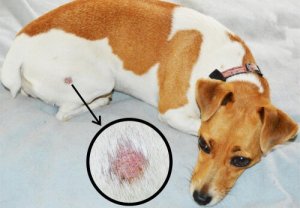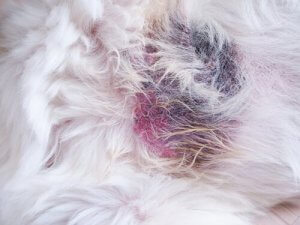Ringworm in Puppies: Symptoms and Treatment

Ringworm in puppies is a common problem. This is because their immune systems have not yet had time to develop properly. Similarly, animals that are suffering from malnutrition or some other serious illness are more susceptible to these parasites, as the body’s natural defenses are weaker than in healthy animals.
Ringworm is a zoonotic condition, meaning it can be passed to humans. Animals suffering from ringworm usually develop an itchy rash, while humans typically develop ring-shaped sores.
In this article, we’ll tell you about the different symptoms of ringworm, and how to treat it.
What causes ringworm in puppies?
Ringworm is caused by a fungal parasite (dermatophyte) that lives in the skin of animals and people. This parasite feeds on keratin, a type of protein found in hair, nails and the outer layer of skin.
There are many different types of dermatophyte, but the majority of cases of ringworm in dogs are caused by Microsporum, Trichophyton and Epidermophyton fungi. The most common species found in dogs is the Microsporum canis.
There have also been a number of cases involving Microsporum gypseum. In this case, rodents act as carriers for the fungus. Puppies can become infected with the parasite after digging in soil close to rodent nests.
As we’ve already mentioned, humans can also suffer from ringworm. Small children, the elderly, and people who are immunocompromised are the most at risk.
Symptoms of ringworm
When it comes to ringworm, symptoms such as itchiness and the appearance of the lesions can vary from case to case, depending on the severity of the infection and the resistance of the fungus.
Dermatophytes only live in hairs that actively grow. Infected hairs break off, leaving patches of short, tufty fur. The animal may also develop crusty sores on their skin, which can range from mild to severe.
Lesions are often accompanied by ring-shaped patches of broken hair or bald spots. The skin often has a crusty or scaly look, and may look red or grayish in color.

In dogs, these lesions normally appear on the paws, head and ears, but they can spread to any part of the body. However, it’s important to mention that puppies suffering from ringworm won’t necessarily show this distinct pattern.
Sores can spread without forming rings, and often look like a number of other conditions, such as allergies.
It’s important to be aware that other, more common, skin complaints can cause similar lesions.
Transmission of ringworm
Ringworm is transmitted through direct contact with infected skin or hair. The fungus produces infectious spores, which are highly resistant and difficult to eliminate from the environment. In fact, they can live for years.
Unfortunately, it’s not just broken or damaged skin that can become infected – dogs with healthy skin can still contract ringworm. While the exact incubation period is currently unknown, some experts believe it is somewhere between 2 and 4 weeks. If the animal is immunosuppressed, this period may be shorter.
Some, apparently healthy pets that aren’t exhibiting any symptoms can become carriers for the infection. This means they can infect other animals, without suffering from any symptoms themselves. Once an animal becomes infected, spores contaminate the environment, and can remain infectious for months.
Diagnosis of ringworm in puppies
You cannot diagnose ringworm from skin lesions alone. Attempting to do so often leads to the wrong diagnosis, and exposes the animal to unnecessary, toxic antifungal treatment.

If one pet catches ringworm, every pet in the house will require treatment, whether they are showing signs or not. Ideally, sick animals should also be quarantined from those not showing any symptoms.
Treatment
If you think your dog might be suffering from ringworm, you must take it to the vet for proper diagnosis and treatment. This is the only way to make sure it recovers properly, and to prevent the fungus from spreading to other pets and people in the family.
Early diagnosis means that your vet will be able to prescribe a less aggressive course of treatment, and reduces the risk of your pet infecting others. Sometimes, simply boosting the animal’s immune system can be enough to help them fight off the infection on their own.
Typically, treatment involves applying a topical fungicide ointment, cream or powder all over the animal’s body. In more advanced or severe cases, your vet may administer a systemic antifungal, either orally or via injection.
If you suspect your puppy might be suffering from ringworm, call your vet immediately for treatment and advice. Disinfecting your home to eliminate any spores requires the help of a professional.
All cited sources were thoroughly reviewed by our team to ensure their quality, reliability, currency, and validity. The bibliography of this article was considered reliable and of academic or scientific accuracy.
- Nardoni, S., Mugnaini, L., Papini, R., Fiaschi, M., & Mancianti, F. (2013). Canine and feline dermatophytosis due to Microsporum gypseum: a retrospective study of clinical data and therapy outcome with griseofulvin. Journal de mycologie medicale, 23(3), 164-167.
- Olivares, R. C. Ringworm Infection in Dogs and Cats (24-Jun-2003). Recent advances in canine infectious diseases. Publisher: www. ivis. org., Ithaca, New York, USA.
- Wright, A. I. (1989). Ringworm in dogs and cats. Journal of small animal practice, 30(4), 242-249.
